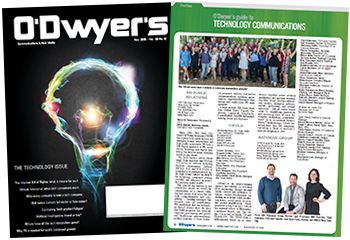|
|
Subject matter experts and technology PR pros should be inextricably intertwined. And in most cases, they are or can be. In other cases, they’re not, and it’s not generally due to personality clashes, although sometimes that occurs too.
Largely, one simply doesn’t know the role the other is supposed to play. That issue is further aggravated by the fact that not all SMEs are created equal.
SMEs are important personas for the PR pro to achieve goals. Most often, the SME in a product marketing organization provides the necessary information used to create new product announcements. But for the heavier stuff, the big artillery, technical SMEs are in great demand to provide detailed content. That big artillery includes byline articles, white papers, eBooks, technical conference papers, and other major PR assets.
|
|
Tech SMEs fall into an array of categories, each one with specific traits the PR pro must clearly spot and understand to be successful, move ahead, and accomplish his or her objectives.
A cooperative, technology-knowledgeable and easy-going SME with no axe to grind is the best of all worlds. When you get this type of SME, you’re more productive and get the job done well and on time. Plus, this SME articulates a topic to the point the marketing asset the PR pro is sourcing is verbally written with little editing necessary.
Generally, this particular SME accounts for about 99 percent of all the good SMEs. But that other one percent is troublesome. To put it mildly, SMEs with certain undesirable traits hand the PR pro some challenges. A PR pro may at first have some trepidation and doubts about dealing with them. However, those difficulties can eventually be overcome by fully understanding the duties you’re responsible for as a PR pro and content marketing writer and what the responsibilities are for the SME.
The PR pro/content marketing writer can confront a variety of SME types. There are major categories. However, a host of others exist sharing many of the same characteristics. The one commonality is this one percent hands the PR pro some level of difficulty. In most instances, it’s based on a strong aversion to cooperation for any number of reasons.
Let’s start with the engineer SME, who focuses more on questioning whether you’re technical and worthy enough to be his/her byline article ghostwriter. Nothing positive is coming out of this big ego SME’s mouth. This one takes considerable objectivity, patience and several sessions to convince him/her that productive collaboration and gathering his/her content will produce good results.
Then, there’s the VP of Marketing SME. He has a promotional bent and no understanding of content marketing versus advertising writing. Instructions coming from this SME are to write about a product’s uniqueness and features and nothing else.
You can say this one is set in his/her ways. It’s the marketing manager SME, who only knows how to communicate with the PR pro via “marketing speak.’’ This is akin to promotional talk, but lacks substantive technical content that conveys solutions that customers are looking for.
Another troublesome engineer SME dislikes the conventional, generally-accepted Associated Press Style of writing and complains he can do a better job of writing in his “funny and quirky” writing style. Unfortunately, this SME doesn’t know or want to understand editorial requirements.
Troublesome SMEs are even in the upper echelons. This is the CEO SME, who wants someone to write an op ed column for him. But he doesn’t have the time or inclination to meet for 20 minutes with the PR pro/content marketing writer to discuss what he wants to say. The PR pro then gathers background materials and tries his/her best to write the CEO’s op ed, in effect, second-guessing the CEO. After spending hours reading half a dozen or more drafts, the CEO still isn’t pleased with what has been written for him. Spending 20 minutes at the outset to nail down this CEO’s thought process would have proven more productive.
Finally, there’s the nice, but disorganized company president SME. He or she fully cooperates with the PR pro/content marketing writer. They meet for 30 to 45 minutes, discussing all the salient points. The downside is this SME’s discussed topics aren’t in sequential order. His or her discussion covers a bunch of subjects, none of them linked together. Here, the PR pro must be a master of puzzles, carefully edit the SME’s original content, and expertly piece together a rational article or other marketing asset.
PR pro/content writer responsibilities
Some tech companies expect the PR pro/content writer to fully understand their technologies and be able to write in depth about them. That’s an absurd assumption, and it’s hard to convince some people of your main roles.
Those roles include understanding the target audience. You must also have a basic understanding of the technical subject you’re writing about. Depending on the marketing asset you’re writing, you have to understand the correct and proper structure to get the highest possible customer readership. It you’re ghostwriting a byline article, understand the target publication’s and editor’s requirements. Also, you should understand the marketing message and unique selling proposition to be embedded in the marketing content.
SMEs’ responsibilities
On the other hand, the SME must understand that team work is essential for effectively producing sound marketing content. Further, it’s critical to fully understand the technology subject being covered and to ensure it’s being communicated clearly and fully. If the SME isn’t able for whatever reason to provide certain technical details, then he/she should recommend a secondary SME who can provide that specific content.
Time is of the essence. An SME must agree to at least a total of two hours per project with that time divided over time into smaller time increments for the purpose of (1) discussing the subject with the PR pro/marketing content writer, (2) reviewing a proposed project outline and (3) reviewing a first cut of the marketing content asset the PR pro writes and making necessary changes/additions to make the content technically accurate.
The basic rule of thumb for the PR pro is to confidently take command of content marketing. He or she must clearly explain the separate roles the PR pro and SME play. Then, the PR pro must take the lead and steadily, effectively move through each step of the content gathering process to achieve that PR goal.
***
Dan Garza is a marketing PR professional and veteran observer of Silicon Valley PR.

 Dan Garza
Dan Garza

 Laura Anderson, who rose to VP/GM of global communications and events in a nearly 20 year stint at Intel, will take on the Americas technology chair at Burson following the completion of the BCW and H+K merger on July 1.
Laura Anderson, who rose to VP/GM of global communications and events in a nearly 20 year stint at Intel, will take on the Americas technology chair at Burson following the completion of the BCW and H+K merger on July 1. WE Communications has partnered with ROKK Solutions to form the WE ROKK AI service.
WE Communications has partnered with ROKK Solutions to form the WE ROKK AI service. In the dynamic world of modern business, effective communication is a pivotal tool for success across various industries. At Communications Strategy Group (CSG®), our expertise in embracing innovation in communication extends beyond traditional marketing strategies, paving the way for transformative industry-specific solutions.
In the dynamic world of modern business, effective communication is a pivotal tool for success across various industries. At Communications Strategy Group (CSG®), our expertise in embracing innovation in communication extends beyond traditional marketing strategies, paving the way for transformative industry-specific solutions. There are two types of tech PR professionals. Which one are you? And are C-suite executives making that decision for you?
There are two types of tech PR professionals. Which one are you? And are C-suite executives making that decision for you? While there’s an impulse to grab reporters’ attention with the newest industry-transforming tech product or service, a back-to-basics approach focused on telling the right stories to the right people is a far more successful way to ensure your technology campaign breaks through the clutter of today’s crowded tech landscape.
While there’s an impulse to grab reporters’ attention with the newest industry-transforming tech product or service, a back-to-basics approach focused on telling the right stories to the right people is a far more successful way to ensure your technology campaign breaks through the clutter of today’s crowded tech landscape.


 Have a comment? Send it to
Have a comment? Send it to 
No comments have been submitted for this story yet.